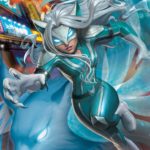
 One of Korea’s greatest warriors returns in this week’s The Death of Doctor Strange: White Fox #1, and it’s a twisted family reunion she likely won’t want to remember.
One of Korea’s greatest warriors returns in this week’s The Death of Doctor Strange: White Fox #1, and it’s a twisted family reunion she likely won’t want to remember.
Last seen with the Agents of Atlas as they battled Namor in Atlantis Attacks, Ami Han—AKA White Fox—finds herself embroiled in a new mystery when she learns there has been a new sighting of a deadly kumiho. Thinking she was the last living kumiho in the world, Ami sets off with her ally Sword Master to get to the bottom of it before their target claims any more victims. Oh, and this is also happening simultaneously with the events of The Death of Doctor Strange, if you couldn’t tell from the title.
Speaking of which: one of White Fox’s best assets is that you don’t really need to be following The Death of Doctor Strange to understand what’s happening. The impetus of that event’s plot is explained succinctly and briefly, allowing writer Alyssa Wong to focus on Ami’s story and build upon her continuing lore. In a way, this is the best kind of event tie-in, using a parent title as a jumping-off point for something completely different that feels standalone and not superfluous (I’d consider The Death of Doctor Strange: Avengers an example of the latter). You could read this and the main series for a fuller experience, but you could also just read White Fox on its own and not feel like you’re missing something. This is especially helpful for fans of White Fox, who may have started reading Marvel comics through her inclusion in the very popular Future Fight mobile game or the Korean web comic Avengers: Electric Rain. The actual story itself is also very good, blending the mythological roots of her character with the sprawling Marvel universe while also hitting some emotional beats relating to family. (And the ending subtly fuels a rumor that a certain character might have some big changes in store for them…)
Andie Tong and Luciana Vecchio share art duties on The Death of Doctor Strange: White Fox, which leads to some visual incongruity in spaces. Their art isn’t analogous enough that one could read the issue and not notice a switch-up from page to page, but it otherwise doesn’t totally disturb the flow of the issue. Tong’s art is appropriately more Eastern flavored, particularly in some sequences that depict Ami’s backstory in a manner meant to evoke scroll paintings, while Vecchio’s pages have his characteristic cartoon-like style. Arif Prianto’s colors do a good job of melding the two into a mostly-cohesive whole, with fairly realistic shading techniques that add a nice dimension to scenes.




